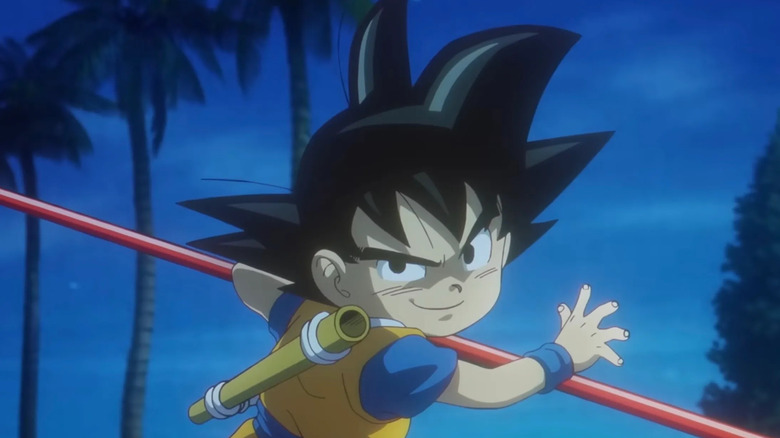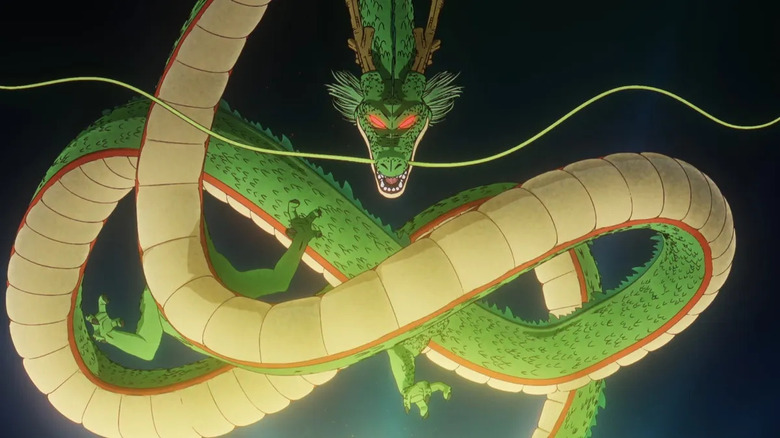Dragon Ball Daima Finally Solves A Big Franchise Problem
"Dragon Ball" is back! The hugely influential franchise finally has a brand new anime for the first time since 2015's "Dragon Ball Super." Titled "Dragon Ball Daima," the series has a unique place in the franchise, being both a sequel to the original "Dragon Ball Z" as well as a prequel to the more recent "Dragon Ball Super." (For a firmer grasp on the franchise, check out our "Dragon Ball" beginner's guide.)
The thing that makes "Daima" both exciting but also deeply bittersweet is that it's the very last project "Dragon Ball" creator Akira Toriyama worked on before his tragic death earlier this year. Toriyama came up with the story and setting for "Daima," as well as many of its designs. The anime series is a delightful throwback to the original, pre-"Dragon Ball Z" era of "Dragon Ball," with a big sense of humor and seemingly more of a focus on gags and adventure than endless training and fighting.
In terms of the story, "Daima" takes place shortly after Majin Buu's defeat, when Gomah decides to claim his rightful throne as King of the Demon Realm following Dabura's death at Buu's hands (well, teeth, really). Anticipating a future ass-whopping by Goku and friends, however, Gomah decides to prevent his demise by turning all the main characters into children with the help of the titular Dragon Balls.
After gathering all the Dragon Balls, Gomah makes his wishes to the Eternal Dragon Shenron. Except, rather that granting three wishes like Gomah expects, the dragon only fulfills one of his wishes before disappearing. It's not like Shenron is partial when it comes to wish-granting; he's always been a neutral figure who doesn't really play sides regardless, even when the person making the wish has wicked intent. Indeed, Shenron has historically provided advice when he sees someone making a wish he considers impractical, and will even offer alternatives. At the same time, Shenron is rather inconsistent. For the entirety of the original "Dragon Ball," Shenron could only grant one wish, only for the Eternal Dragon to start granting three wishes on "Dragon Ball Z" ... sometimes.
Now, we finally have a definitive answer as to how Shenron's wish granting works in the "Dragon Ball" universe.
How many wishes do the Dragon Balls grant?
When Gomah complains to Shenron in "Dragon Ball Daima" episode 2, "Glorio," that he isn't getting the rest of his wishes granted, the Eternal Dragon explains that Gomah is a first timer and only regulars get extra wishes as a bonus. We knew that Shenron's powers had limitations and loop holes, such as not being able to revive someone twice (at first), or not being able to revive those who've been dead more than a year, but this is new.
It seems Shenron does, in fact, play favorites, and he literally treats wishes as a reward for repeat costumers. This puts every encounter with the Z fighters in perspective while also painting his granting of the wishes that saved them so many times in a new light. To be sure, it appears that Shenron wasn't nearly as neutral as we thought he was, but found subtle ways to help the people he liked. (The fact that Goku and the others revived Shenron and otherwise didn't abuse him probably helped.)
Akira Toriyama was never afraid to retcon his work, of course, from tweaking Goku's origin as a Saiyan making him like Superman to making Piccolo an alien and even changing the origins of the Dragon Balls themselves. That's part of what makes "Dragon Ball" so much fun, and "Daima" makes that a core part of the new series. Welcome back, Son Goku!
"Dragon Ball Daima" is now streaming on Crunchyroll.

